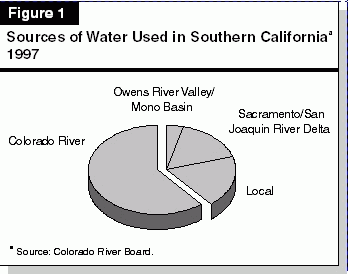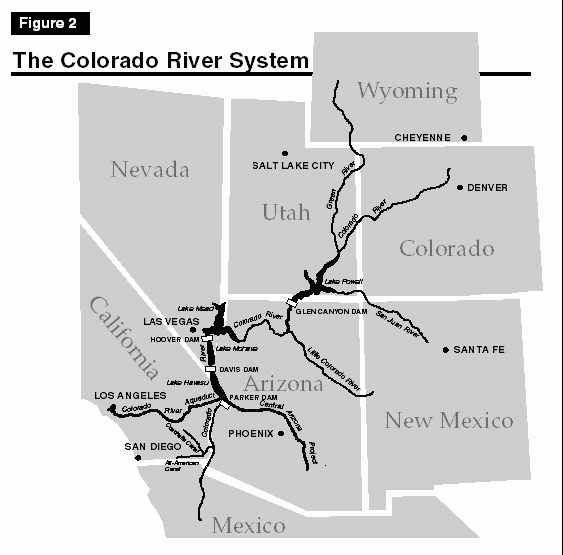
 |
Colorado River Water: |
Background |
The Colorado River supplies over 60 percent of the water used annually in Southern California. California is currently using 20 percent more Colorado River water than it is entitled to under the "Law of the River." The Secretary of the Interior has directed California to come up with a plan to live within its entitlement of 4.4 million acre-feet of water per year. |
LAO Findings |
|
LAO Recommendations |
|
The Colorado River supplies about 14 percent of the water used in California by agriculture, industry, commercial businesses, and residential customers. As shown in Figure 1, Colorado River water is by far the most important source of water used in Southern California--accounting for over 60 percent of its water supply. In 1997, the Colorado River will provide about 5.2 million acre-feet (maf) of the 8.4 maf of water used in Southern California. (One acre-foot of water supplies about two three-person households for one year.)

The rights of these seven states and Mexico to use Colorado River water is governed by a series of agreements, treaties, laws, and court decisions, collectively referred to as the "Law of the River." Under this law, the "Upper Basin" states (Wyoming, Colorado, Utah, and New Mexico) and the "Lower Basin" states (California, Nevada, and Arizona) are each collectively entitled to 7.5 maf of Colorado River water in a normal year. From within the Lower Basin states' entitlement, California is entitled to 4.4 maf of water. Agriculture has first priority to about 90 percent of California's entitlement; the balance goes to the Metropolitan Water District of Southern California (MWD) which operates the Colorado River Aqueduct to deliver to urban users. While entitlement holders receive the Colorado River water essentially for free, the ultimate water users pay for the costs of the delivery systems.
The Secretary of the Interior--as "water master" of the Colorado River--can annually adjust a Lower Basin state's entitlement, by:

Relying on Other States' Unused Water. Figure 3 (see page 4) shows the entitlements of Colorado River water versus actual use. Historically, California has used more water than its entitlement. California's use above its entitlement has been made possible through a reallocation of unused water from Arizona's and Nevada's entitlements.
| Figure 3 | |||
| Colorado River Water: Entitlements Versus Usea | |||
| (In Thousands of Acre-Feet) | |||
| Use | |||
| Entitlementb | 1985 | 1997 (Estimated) | |
| Lower Basin | |||
| California | 4,400 | 4,712 | 5,168 |
| Agriculture | 3,850 | 3,443 | 3,922 |
| Urban | 550 | 1,269 | 1,246 |
| Arizona | 2,800 | 1,200 | 2,800 |
| Nevada | 300 | 115 | 250 |
| Upper Basinc | 7,500 | 4,000 | 4,300 |
| Mexico | 1,500 | --d | --d |
| a Source: Colorado River Board/U.S. Department of the Interior. | |||
| b Entitlement is for a "normal" (nondrought) water year, according to "Law of the River." | |||
| c Includes Wyoming, Colorado, Utah, New Mexico, and a small portion of Arizona. | |||
| d Not available. | |||
Beginning in 1996, however, there was not enough unused water from these two states to be reallocated to California to fully meet California's demand. In future years, it is expected that only a small amount of water--from Nevada's entitlement--will be available for reallocation to California. This is because water use in Arizona and Nevada has increased as a result of the rapid population growth in these states. Additionally, Arizona has started to "bank" its water (such as by groundwater storage) to protect against future shortages.
Nonetheless, California received in 1996 about 800,000 acre-feet above its entitlement due to a small reallocation of water from Arizona and Nevada's entitlements and a first-time declaration by the Secretary of surplus conditions on the Colorado River reflecting nearly full reservoirs. Under the Law of the River, California is entitled to one-half of the surplus water available to the Lower Basin states. For 1997, California will continue to receive about 800,000 acre-feet above its entitlement because the Secretary has again declared a surplus condition.
California's Demand Will Increase, But Supply May Be Cut Back. The Department of Water Resources projects that, over the next several decades, California's demand for Colorado River water will continue to increase, with increases in urban demand outweighing the projected declines in agricultural demand. For example, the department's 1993 California Water Plan projected that urban water demand will increase by 60 percent from 1990 to 2020. However, California's ability to access Colorado River water beyond current levels is limited for two reasons.
The Secretary has advised California that, without such a plan, he will operate the Colorado River system "more conservatively" beginning in 1999. This reflects the stated intention of the other Basin states to oppose surplus water declarations in future years without an acceptable California plan. Conversely, if California has an acceptable plan for living within its entitlement, the Secretary could make water available to the state beyond its entitlement through a water surplus declaration. Absent such a declaration, California would have no entitlement to Colorado River water beyond 4.4 maf.
If California were to live within its 4.4 maf entitlement today, the immediate impact would fall mostly on the MWD because almost all of the allocation to California above its entitlement now goes to urban users serviced by the MWD. The MWD (or its customers) would have to look to (1) other users of Colorado River water, namely the agriculture agencies, or (2) other sources--such as Northern California water supplies--for about 700,000 acre-feet of water that the MWD currently delivers. Freeing up water from agricultural usage for transfer to urban users could require changes in irrigation practices or reductions in crop acreage, while increasing diversion of Northern California water to Southern California could require changes in water usage in Northern California.
Other Issues. California faces other issues that may impact the quantity or quality of the supply of Colorado River water to certain users. In particular, listing of additional endangered bird and fish species could reduce the amount of water available for nonenvironmental purposes. Also, federal funding for Colorado River salinity control projects (which leverages contributions from water users) is less certain than in past years and will likely be reduced over the coming years. To the extent projects to maintain water quality standards are deferred or delayed due to inadequate funding, the quality of Colorado River water supplies would be adversely affected. This, in turn, would affect the type of agriculture in the area serviced by the Colorado River (crops with the highest market value generally require water which is low in salinity) as well as the quality of Southern California drinking water
In accordance with the Secretary's directive, the board has been developing a plan for California to live within its entitlement of 4.4 maf. The board's draft plan (dated August 11, 1997) includes the following major components, all of which are focused on changes in the use, supply, or transfer of Colorado River water. The plan relies first on a variety of intrastate measures which either conserve water or increase water supplies. The plan then relies on measures which would make extra water available to California. These include purchasing water from other states and revising the river's reservoir operations. Adoption of these measures is contingent on preapproval or other action by the Secretary since other Basin states would be affected.
Intrastate Measures to Conserve Water and Increase Water Supplies. The plan identifies potential measures in both the agricultural and urban sectors to conserve water or make water use more efficient. These include wastewater recycling and water desalination. As regards the agricultural sector specifically, it includes changes in irrigation methods to increase water use efficiency, the lining of canals that deliver water for agricultural use in order to reduce wastage, and land fallowing programs in dry years. In addition, the plan identifies intrastate measures which would augment water supplies, such as groundwater storage.
Agricultural-to-Urban Intrastate Water Transfers. A primary component of the plan is the transfer (selling) of water freed up from agricultural use (pursuant to the above measures) to urban use--where demand is growing. Since existing law authorizes intrastate water transfers, the Legislature should address or clarify a number of issues in order to facilitate these transfers.
First, depending on the circumstances, a water transfer could adversely impact interests outside of the buying and selling parties to the transfer. These "third party" impacts may be economic (such as those on businesses and workers that support particular water users) or environmental. Current law does not generally provide a formal process for the evaluation of third party impacts when a transfer is proposed. Accordingly, these impacts may go unaddressed, or transfers may be impeded as opposition from third parties arise. In order to ensure appropriate evaluation of third party impacts and to facilitate transfers, the Legislature may want to establish a formal evaluation process. Additionally, the Legislature may want to provide greater statutory direction as to the level of protection to be provided outside interests impacted by transfers.
In addition, disputes have arisen regarding what constitutes "fair compensation" for the use of water conveyance facilities, such as the Colorado River Aqueduct. (Current law requires that the buying and selling parties to a water transfer pay "fair compensation" to use such facilities.) Also, in order to facilitate transfers from agriculture, the entitlements of individual agriculture water agencies (which collectively have the first priority to use Colorado River water) will need to be clarified.
A number of bills were introduced this session to facilitate intrastate water transfers, including SB 1011 (Costa), SB 1082 (Kelley), SB 1335 (Polanco), and AB 554 (Papan). To date, the Legislature has enacted only SB 1082 which would facilitate a transfer of water between two Colorado River water users (the Imperial Irrigation District and the San Diego County Water Authority) by providing a process to resolve issues about charges to convey the transferred water.
Interstate Water Transfers. The draft plan identifies the purchase of Colorado River water from the other Basin states as a means to supplement or replace the "free" water that currently is made available to California by the Secretary through any reallocations or surplus declarations. While there has been no transfer (purchase) of water from the other Basin states, the Secretary indicates that he will approve such transfers if the transfers are not permanent, are mutually agreed to by the selling and purchasing states, and do not adversely impact other users. The amount of these transfers, however, would be limited by the capacity of the delivery systems.
Revised Reservoir Operations. Reservoirs on the Colorado River are operated mainly for flood control
purposes. Currently, these reservoirs have about 50 maf of water in storage (about 90 percent of total
capacity). The draft plan identifies the potential for the Secretary to draw down these levels when physical
conditions permit, and make the water available for use by California. However, the other Basin states have
stated that they will not agree to such revised reservoir operations (which could provide California with
additional "free" water above its entitlement) unless the plan contains other measures whereby California
reduces its dependence on Colorado River water.
Statewide Solution Should Be Considered. The challenge facing California to reduce its dependence on Colorado River water is not only imminent, but also will increase over time. This is because total statewide water demands are projected to increase over time. Given this, we believe that the Colorado River Board should expand the current focus of its plan to consider statewide measures in addition to those which pertain solely to the use, supply, and transfer of Colorado River water.
For example, the board might identify water conservation measures that could be implemented in Northern California so as to free up water for transfer and sale to a Colorado River water user in Southern California. In considering statewide measures, the board should make use of the information resources of the Department of Water Resources as that department is developing the 1998 California Water Plan.
Legislative Oversight. While we do not yet know the final components of the board's plan, it is likely that a combination of measures will be required to reduce California's dependency on Colorado River water. It is important that the Legislature be kept advised of the development of the board's plan for a number of reasons. First, the Legislature should ensure that the board is proceeding with the development of its plan in a timely fashion, given the serious economic consequences of an immediate supply reduction that is likely in the absence of a plan. Second, legislative oversight is necessary to ensure that the economic and environmental impacts of the plan are given due consideration and that an appropriate range of measures is considered.
One mechanism for the Legislature to monitor the development of the board's plan is through the quarterly reporting requirements adopted by the Legislature in the Supplemental Report of the 1997 Budget Act. In order for the Legislature to conduct effective oversight of the board's development of the plan, we recommend that the Legislature hold hearings prior to the plan being submitted to the Secretary next year. At such hearings, the Legislature should be advised of:
Only with this information will the Legislature be able to ensure that the measures in the plan are consistent with overall legislative priorities.